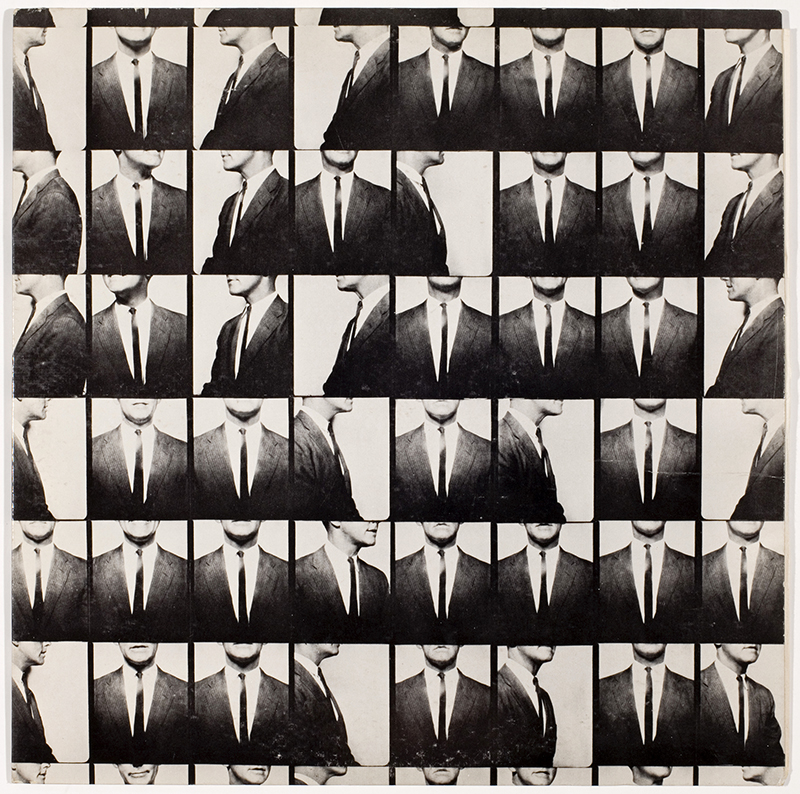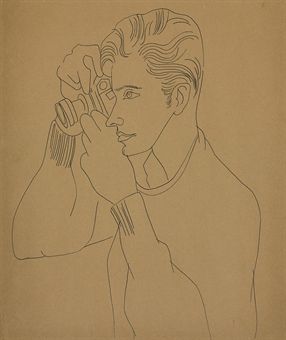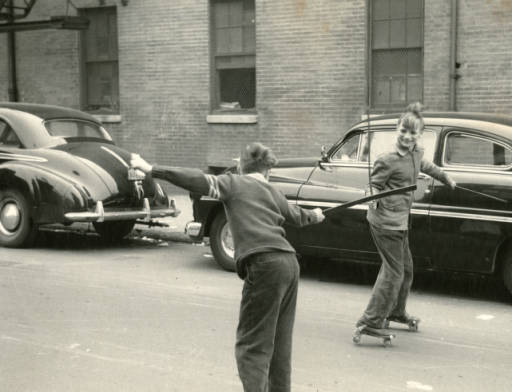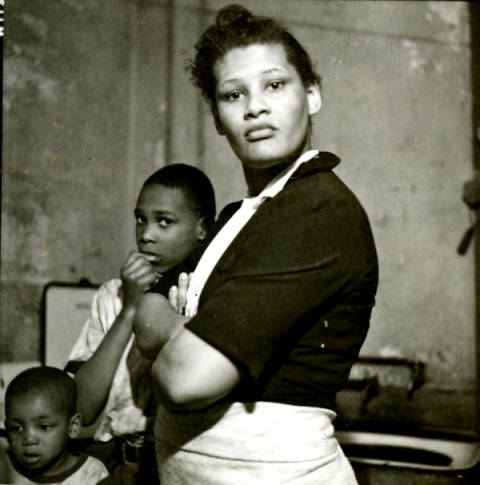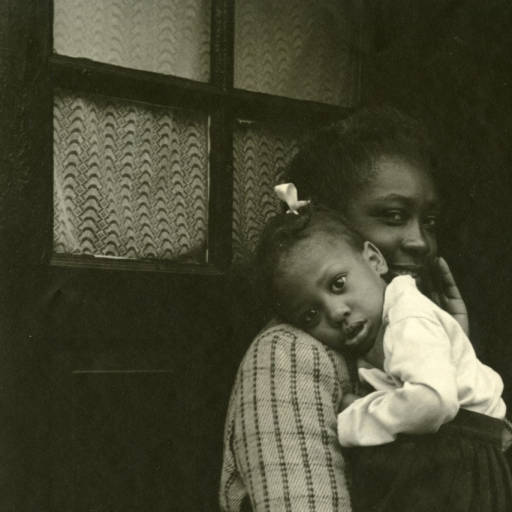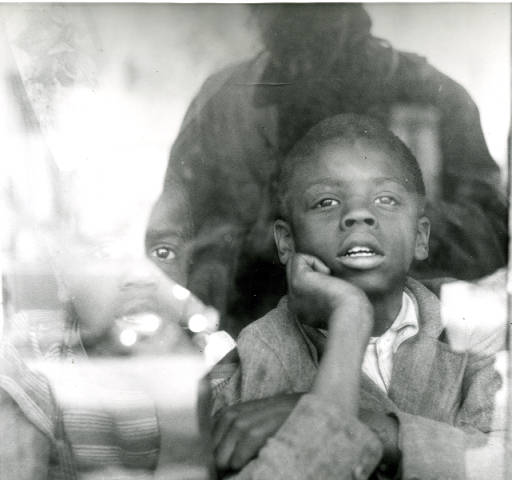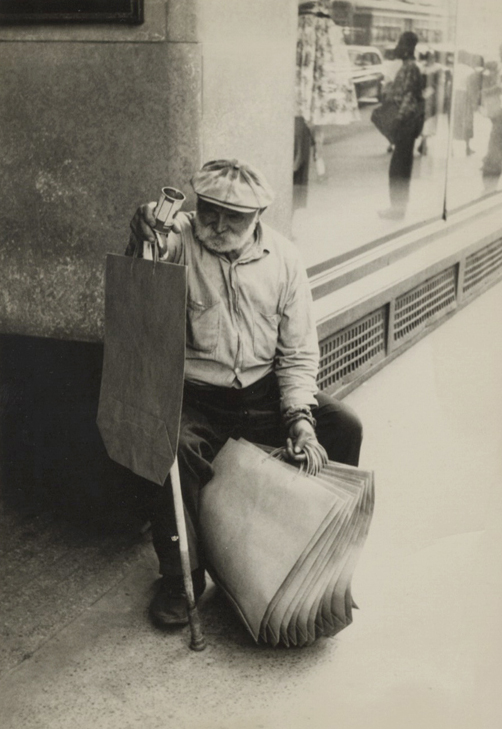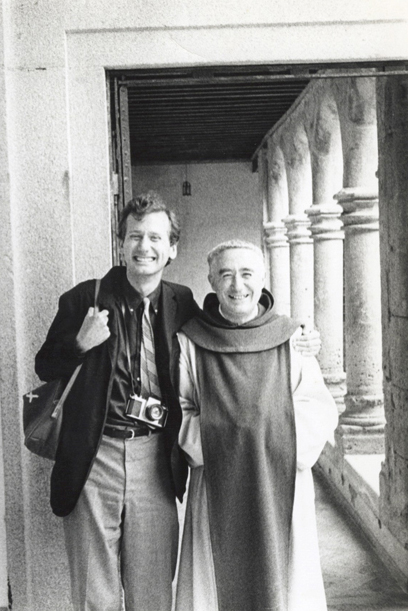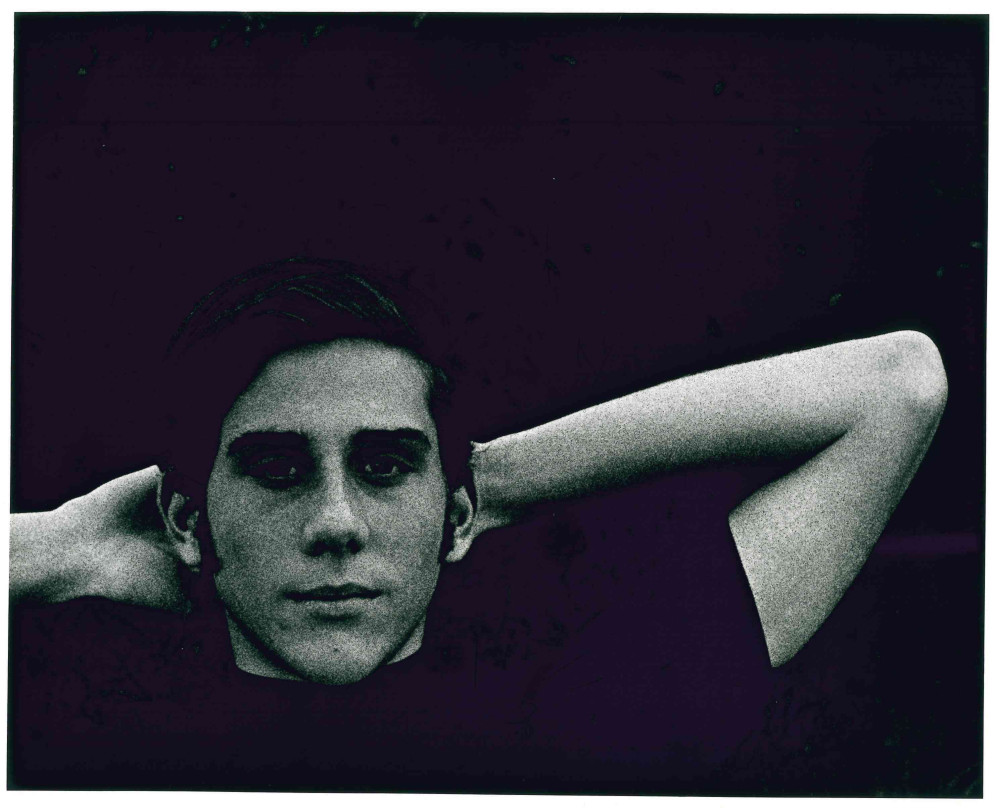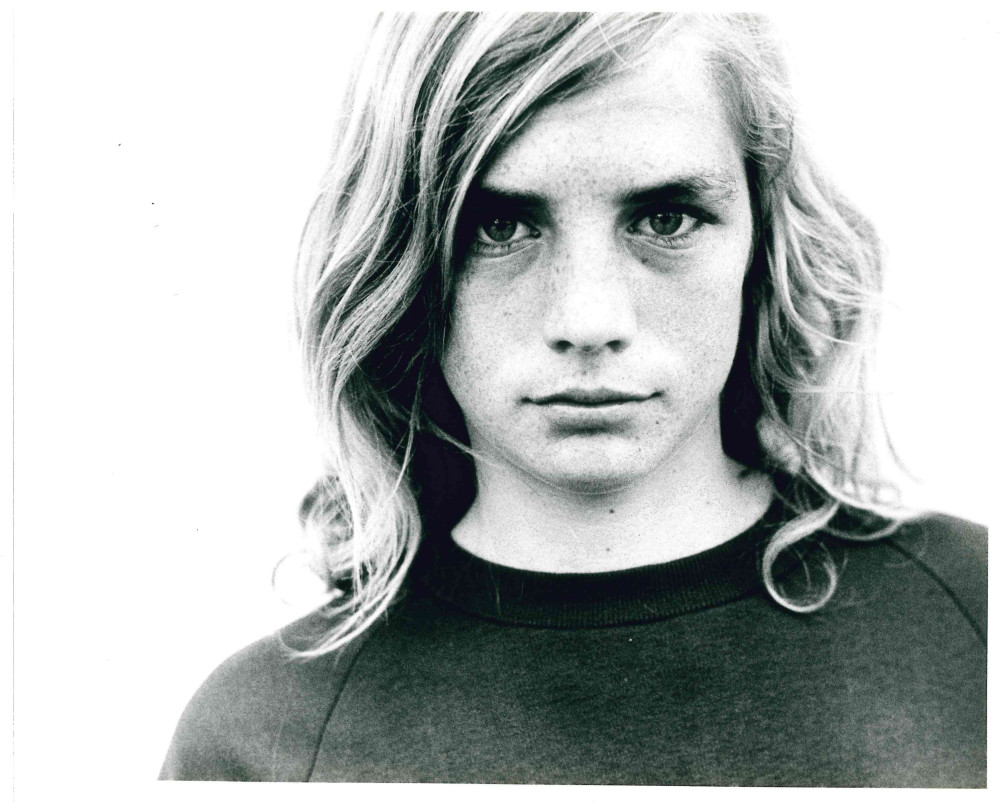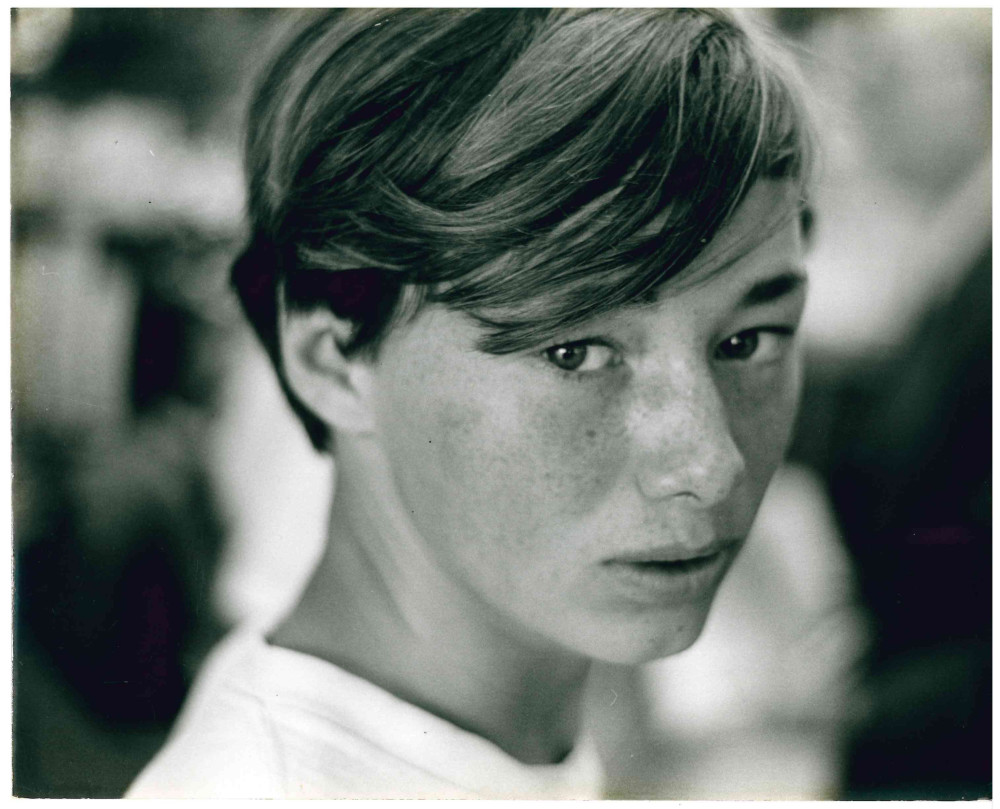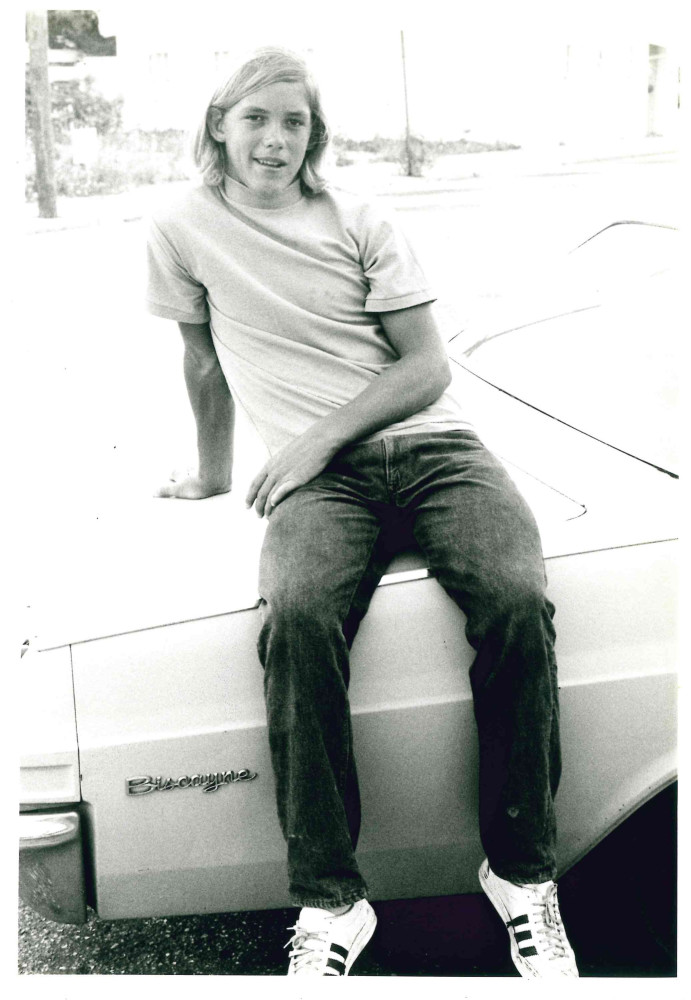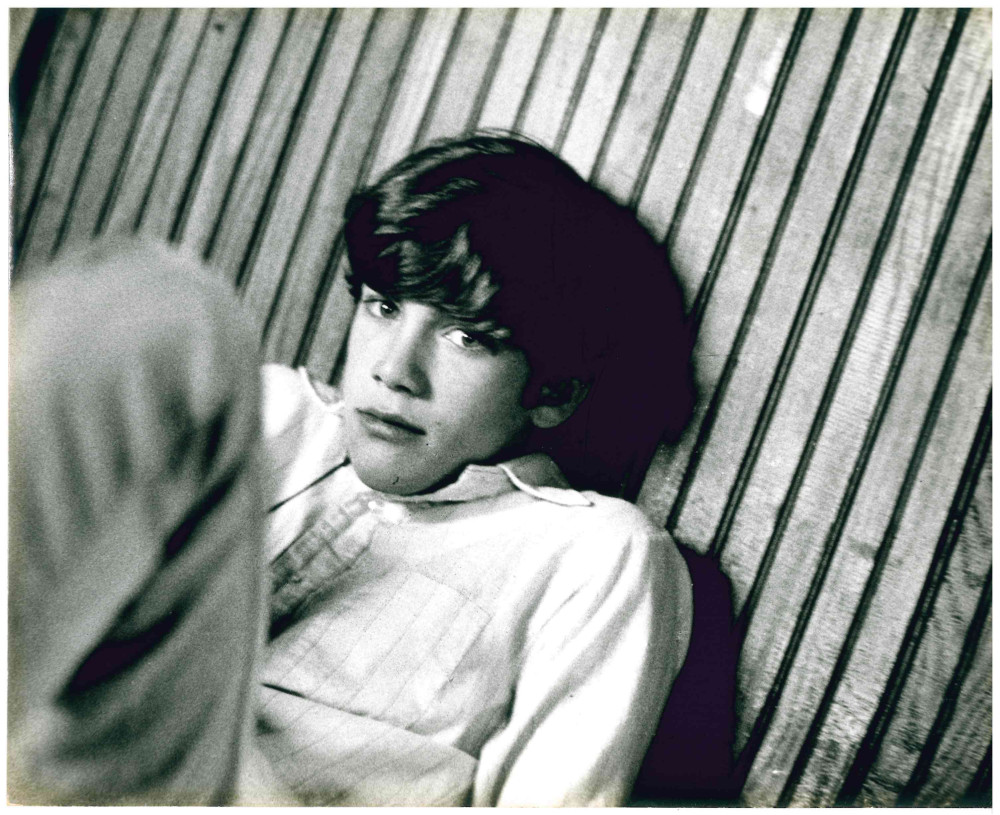It takes a bit of chutzpah to present a retrospective exhibition of Balthus’ controversial work at the time of the #Metoo movement and following a failed campaign in 2017 to have his painting Thérèse Dreaming removed from the Met. in New York. But the Beyeler in Basel has no qualms and has risen above the fray. There is even a Balthus Family Day, with guided tour, interactive events, tableaux vivants, children and young people admitted free. The shop sells Balthus placemats and screen cleaners printed with Thérèse Dreaming. The show goes on.
There have always been philistines of course. We live at a time of backstabbing in the senate, poisonings and dismemberings in the diplomatic missions, charlatans and crooks in the highest corridors of power and Facebook in the Forum. So it is no surprise that the moralists are once again trying to sanitise painting. It’s an easy target in the current culture wars: first they come for the immigrants, then they come for the degenerate art. On American art, the writer John Updike was of the opinion that “Puritanism continues to shape our collective aesthetic sensibility… There is an American tendency to see art as a spiritual feat, a moment of amazing grace.” The outcome of the petition instigated by Mia Merrill, ultimately garnering 12,000 signatures, is that the Met has stuck to its values and is having none of it.
This is my third Balthus exhibition, so I feel I know a thing or two about his life and work. I was bowled over in the Centre Pompidou, back in 1983, by the large-scale retrospective that subsequently travelled to New York. There was a careful summing-up at the under-estimated Fondation Pierre Gianadda in 2008 in Martigny, co-curated by Jean Claire, former director of the Picasso Museum in Paris, seven years after Balthus’ death. The current Beyeler show is more like a greatest hits, with forty major canvases, many of them masterpieces, spanning the artist’s long career.
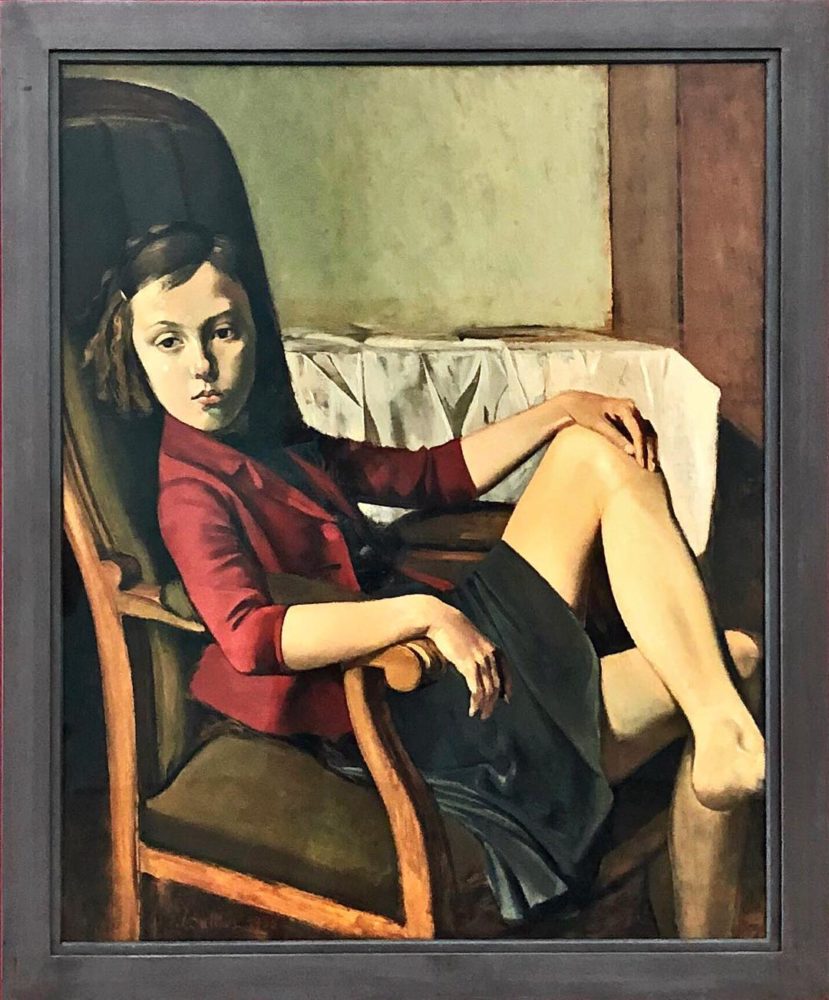
Thérèse (1938) by Balthus. Metropolitan Museum of Art New York.© 2018 Artists Rights Society (ARS), New York
Balthasar Klossowski was born in 1908 to a Polish painter, art historian and collector resident in Paris, and his wife, Elizabeth, née Spiro. She was a Polish Jew, daughter of a cantor, and became the lover of the Bohemian-Austrian writer Rainer Maria Rilke. Balthazar had an older brother, Pierre. The mother went by the name of Baladine. The boys looked up to Rilke as mentor and father substitute. It was an artists-in-the-house sort of upbringing, with the great names of the French literary and artistic world – Valéry, Gide, Bonnard – around the hearth, on the shelves and hanging from the walls. High Bohemia, then, with a Scottish nanny. Baladine settled in Switzerland with her poet friend, and the boys shuttled back and forth between Geneva and Paris on the train.

Balthazar and Pierre Klossowski, Paris, circa 1913 © Fonds Balthus
Pierre Klossowski, who became André Gide’s secretary at age eighteen and helped him with the drafts of Les faux-monnayeurs, developed into a writer and artist every bit as controversial and sexually-obsessive as his more famous brother Baltusz, as it was spelled at the time. Pierre was a lifelong devotee of the work of the Marquis de Sade – and sadomasochistic scenes, the need to control for sexual and aesthetic purposes, recur in Balthus’ work as well.

Rainer Maria Rilke, the young Balthus, his mother Baladine, Beatenberg, Switzerland, 1922© Fonds Balthus
In later decades Balthus would develop what the New York Times calls a “romantic counter identity” which surely must rival Kellyanne Conway’s “alternative facts” as fudge of the century. Balthus airbrushed out his mother’s Jewish origins. He gave himself the title of Count de Rolle. At one point he claimed descent from Byron (that Scottish nanny) and the Gordons of Scotland. Polish royalty got mixed in for good measure. All lies, or fake news or whatever you want to call it. No substance. No evidence. But it does point to a willingness to change facts to fit an idea of himself. The unhinged never imagine themselves as Joe Soap: it’s always Napoleon or Alexander the Great. The urge to aggrandise, the Byronic cast, nonetheless, tells us a lot about the artist’s method – to turn base metal into gold – but also perhaps something about his approach to sexuality. Balthus was the kind of controlling pre-internet fantasist who might have believed his own schtick.

Invitation card to Balthus’ first solo exhibition in Paris, 1934
He was a quiet provocateur. His first solo show at age 26 in 1934 in the Galerie Pierre (Matisse, son of Henri) in Paris excited controversy. Exhibiting just seven canvases, none of which sold, Balthus felt his work had been wrongly roped in with the surrealists, in vogue at the time. The principal source of controversy was La leçon de guitare (1934), now in the private collection of the Niarchos shipping family and not seen publicly since 1977. It depicts a girl with arched back in the lap of her female teacher, whose hands appear to play the girl as though playing the guitar: one near her exposed crotch, another grasping her hair. Perhaps now is not the time to dust it off. The subject matter takes down the pegs on a long tradition of music lessons depicted as seduction scenes. The composition also blasphemously parodies a deposition from the cross, Pietà de Villeneuve-lès-Avignon, from circa 1455. Throughout his career Balthus liked to dress his girls – when he dressed them – in high-falutin’ clothes. As recently as 2001 the New York Times refused to reproduce the offending canvas which art critic Robert Hughes called “one of the few masterpieces among erotic paintings by Western artists in the last fifty years.”
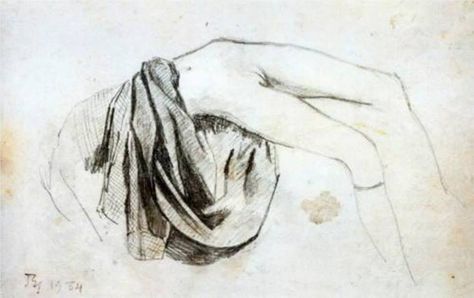
Study for La leçon de guitare, 1934
The Beyeler shows a number of canvases from that first 1934 exhibition. Two are of the Luxembourg Gardens (he was clearly an habitué of that Parisian playground) and one other street scene, in the Place de l’Odéon. They reveal motifs and idiosyncrasies that are to remain in the artist’s work throughout his career. We have a baker’s boy in white apron carrying a tray of bread on his head – he makes a further appearance in La Rue from 1933. Recurring also is a man with a ladder. In Le Jardin du Luxembourg from 1928, a youth in an Eton collar with a tennis racquet and a beret with a red pom-pom. A small girl strains to pick up a tennis ball. Balthus is learning to manipulate mystery, raising more questions than he answers, as his confidence and technique mature.
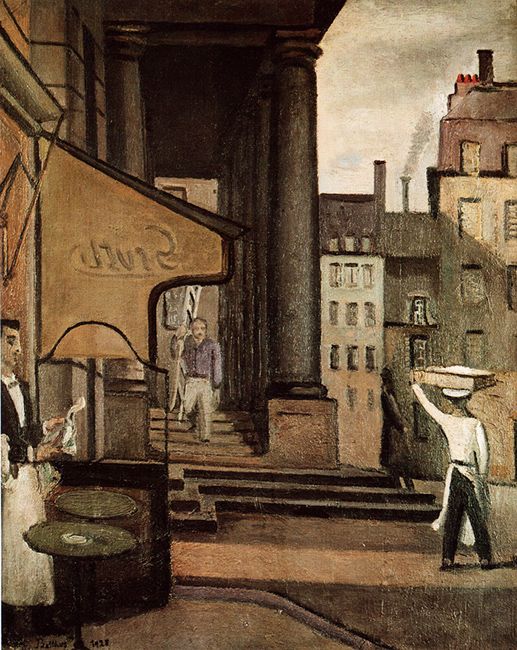
Balthus, Place de l’Odéon, 1928, private collection Paris
I particularly like this painting of the Place de l’Odéon because I sat often at that café terrace in the late Seventies and early Eighties. My agent at the time, Mary Kling, had her office, La nouvelle agence, up the street a bit towards the Luxembourg Gardens and I used to present myself with my paltry typewritten juvenilia, hoping she might offload them somewhere, anywhere… My nickname for her was “Kling-a-Ling” because of all those non-sequitur phone calls from the basements of cafés and streetside kiosks.

Balthus, La Rue, 1933, MOMA, James Thrall Soby Bequest
La Rue, from 1933, is the first of Balthus’ masterpieces. There are six different types of hat on the nine figures in the street, promenading with all the deliberation of actors coming on stage. The street depicted is rue de Bourbon-le-Château, near which Balthus had a studio in the Cour de Rohan, in the heart of Paris’s 6th arrondissement. Balthus exaggerates the hats to create effects, blurs and foreshortens footwear. His figures are remarkably consistent in footwear, wearing similar slippers, espadrilles or ballet shoes over seven decades of painting life. (In a later LIFE magazine feature the artist and his young model are photographed in red leather babouche slippers.) He liked to manipulate his sitters, to flatten a head, distort a shoulder, thicken an ankle, according to the necessities of his aesthetic. They appear isolated, mannequin-like, automatons in his service. Clearly, Balthus has been looking at Seurat’s way of freezing time in a moment, framing the circus.
The dwarfish girl with bat and ball reappears. Another girl, in white ankle socks and little red top, is being assaulted by a youth wearing red spats. A striking cap sits on a woman with her back to the viewer, her jerkin trimmed with red. The peculiarly adult child carried by a nursemaid has another red pom-pom on his beret, so flattened it looks like a mortar board. His mother or nursemaid has an elaborate chignon, a green and beige scarf. She too is facing away from us – a mystery figure. The play of pattern between costume and street – a striped awning, a fragment of a huissier de justice sign, a gas lamp, an electric lamp – all underscore the theatricality of the scene. But what does it all mean?

Rue de Bourbon-le-Château, Paris VI
The Thérèse paintings – about eleven of them executed over the period 1935-1939 – show Thérèse Blanchard, the daughter of Balthus’ neighbour in Paris. One of the earliest, a canvas that once belonging to Picasso, shows her with her younger brother Hubert. The two children are stiffly posed, the drawing girl on the floor more mannequin-like than her brother. She is all angles and lines, her limbs somewhat detachable, her head swivelled peculiarly, like a doll’s. Balthus had earlier used this composition in a series of illustrations for Heathcliff and Cathy in Wuthering Heights. The Thérèse paintings capture shifting puberty, a sullen porcelain quality to the sitter but also the artist’s own obsession: he wants to aestheticise what’s fleeting in her.

Les enfants Hubert et Thérèse Blanchard, 1937, Picasso Museum in Paris
Art critic, curator and Balthus specialist at the Met., Sabine Rewald, describes Thérèse as “young yet knowing, vulnerable yet tough.” Thérèse Dreaming (1937) has crossed the Atlantic from New York to show her knickers in the Basel show: the Met. are probably quite happy to get her out of the house for a breath of bracing Swiss air while the petition against her dies down. Rewald wrote in the Metropolitan Museum Journal of 1998: “The picture presents a haunting description of that stage in life that veers between lassitude and exuberance, innocence and sexual fantasies, reality and dream”.
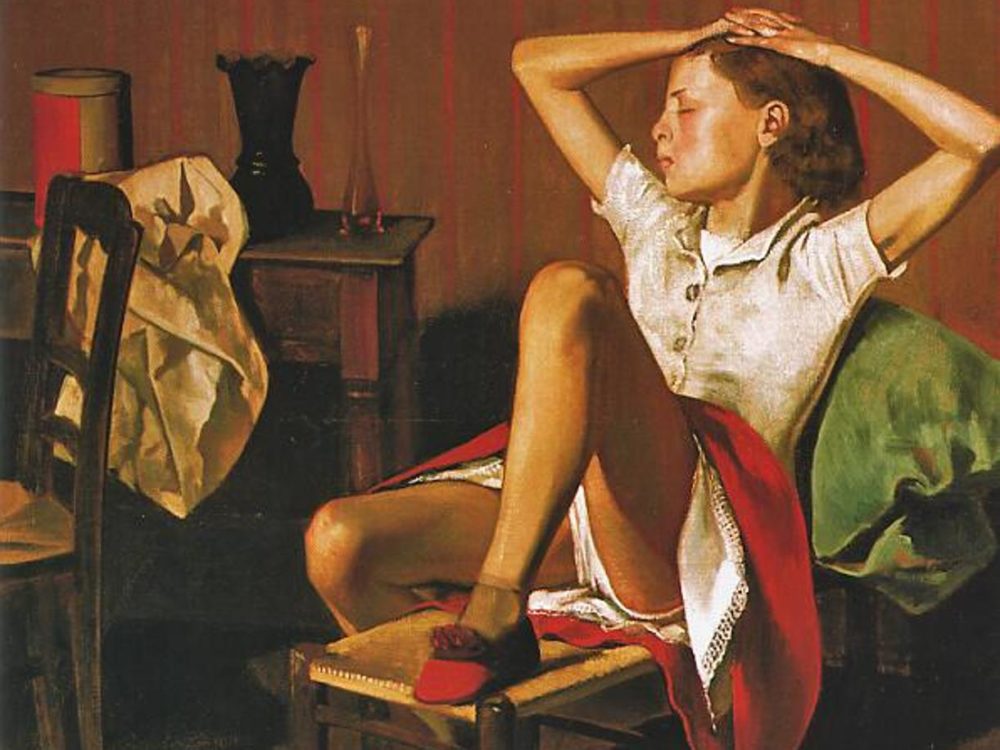
Thérèse Dreaming, 1938, by Balthus, Metropolitan Museum of Art, New York, Jacques and Natasha Gelman Collection, 1998
Balthus plays off a strict, classicising composition against the eroticising pose; as Alan Bennet puts it in a different context in The Habit of Art: “all that counterfeit classical luggage” seems ornament to cornered desire. Balthus has managed to show “intuition into his young model’s psyche with an overt erotic desire”. This discrepancy between a disturbing content and a classic form is far from new in art (Chronos and cannibalism, anybody? Leda and the Swan?) but the persistence of figures, poses and clothing over many decades points to an obsession. The artist’s only recorded comment on this particular Thérèse painting has a dissembling grain of truth but seems disingenuous nonetheless:
Everyone is excited because you can see the little girls’ underpants. . . . The problem is the viewer’s longings and interests, not mine.”
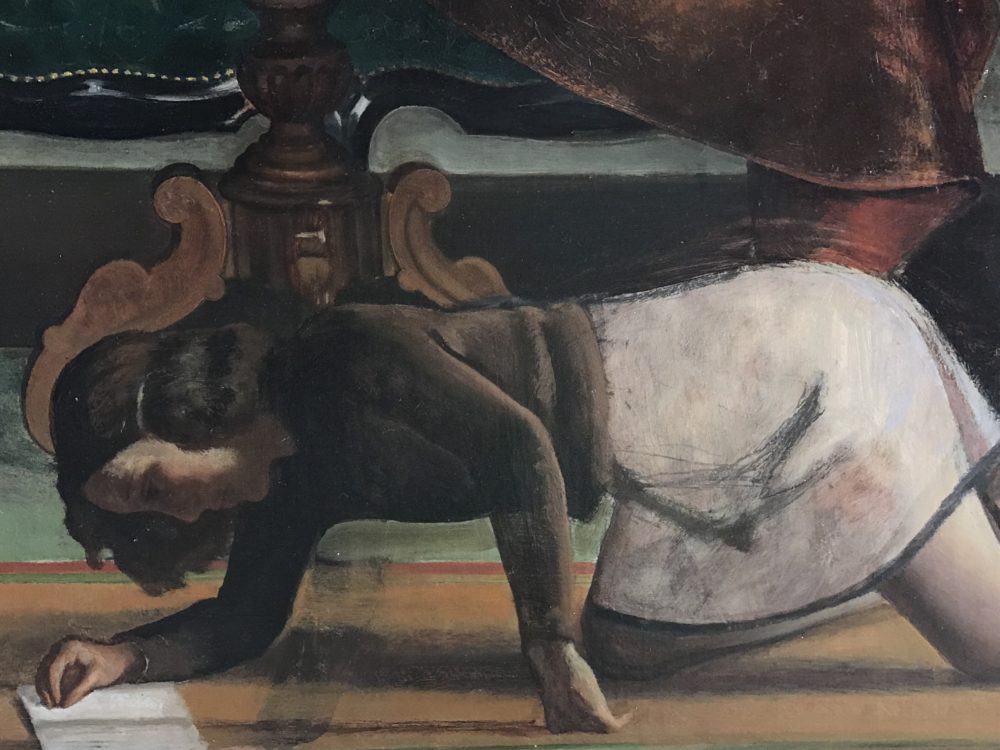
Detail from Living Room, 1943, by Balthus, Minneapolis Institute of Art, ©Artists Rights Society (ARS), New York / ADAGP, Paris
Balthus courted and eventually married in 1937 Antoinette de Watteville, a Swiss of aristocratic family. They first met when she was twelve in 1924. They had two sons. Laurence Bataille, daughter of French writer George Bataille and actress Sylvia Bataille, became Balthus’ mistress at age sixteen, when he was thirty-eight. He took up with Frederique Tison, his step-niece, when she was sixteen. Balthus didn’t just sublimate his desires in his paintings, he was active in pursuing girls and using them as his models. A more moralistic, age-aware and information-savvy time like ours can look through these liaisons and seductions and see the power dynamics behind them.

Laurence Bataille, age 4, in Bourg d’Oisons. Photo © Denise Bellon.
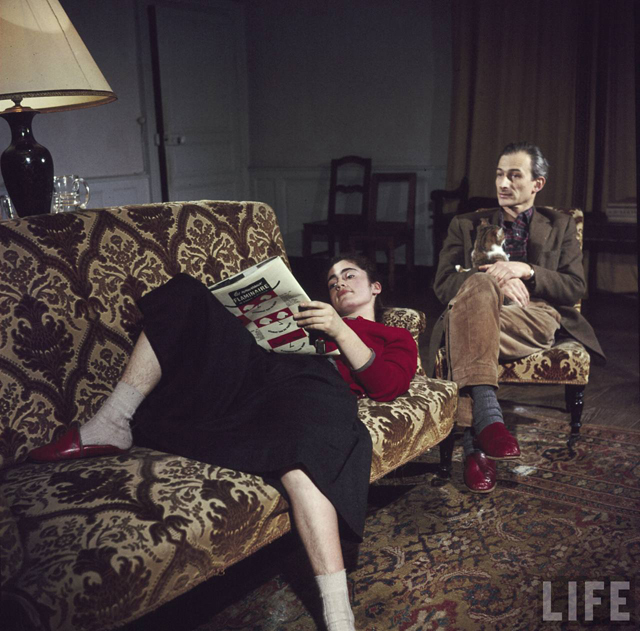
Balthus with his step-niece Frederique Tison, in Chateau de Chassy, 1956. Note the red leather babouche slippers.
French writer André Malraux and Balthus met for the first time in 1946 in the Restaurant du Nord in Geneva, where Malraux was giving a talk. They had in common a passion for Chinese and Japanese art and a fascination with cats.
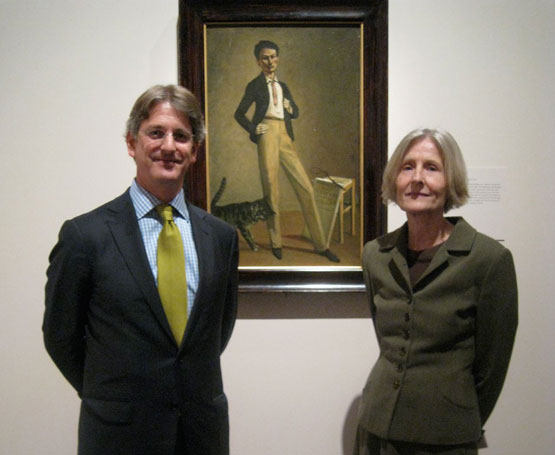
Tom Campbell, Director of New York’s Metropolitan Museum of Art and Sabine Rewald, curator, with Balthus’ King of Cats, 1935, between them in 2014. © Jill Krementz
Balthus had styled himself “King of Cats” since a 1935 self-portrait. His first publication, at Rilke’s instigation, when Balthus was twelve, was Mitsou, an illustrated tale about a lost stray cat. A retrospective exhibition focusing on this feline connection, Balthus: Cats and Girls, curated by the world’s foremost authority on the artist, Sabine Rewald, showed at New York’s Metropolitan Museum of Art in 2014 without a purr.

Ink drawings by Balthus for Mitsou, his first publication in 1921
Appreciation for Japanese woodcuts dated back to Balthus’ childhood on the Rue Boissonade in Paris. At fourteen, he had been painting Chinese lanterns and Rilke describes his “assured knowledge of Chinese Imperial and artistic dynasties”. In 1946 Balthus continued the conversation with Malraux the following day at the Villa Diodati outside Geneva (of Byron fame), where the artist was living. The friendship between Malraux and the artist lasted thirty years.
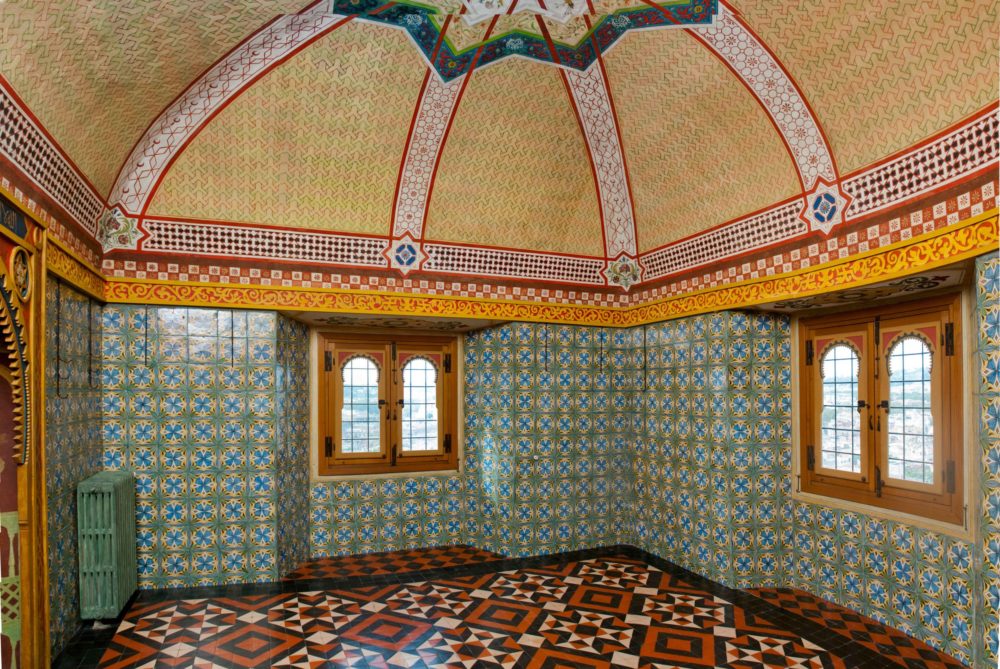
The Turkish room at the Villa Medici, Rome
It was Malraux who saw to it that Balthus got the position of Director of the French Academy in Rome, a six-year sinecure which he stretched to sixteen. Balthus was always fond of a nice house, and lived in a succession of grand residences throughout his life: the Villa Diodati, the Château de Chassy in the Morvan, the Grand Chalet at Rossinière in Switzerland. The Villa Médicis in Rome, where the French Academy is housed, needed restoration and Balthus devoted time and energy to the task. In 1966 Malraux, in his capacity as Minister of State in charge of Cultural Affairs, inaugurated the restoration work.

Balthus’ painting La chambre turque (1965-66) on the French 4 franc stamp, issued in 1982
The two men visited Japan in 1962. Malraux was in search of works for an exhibition of Japanese art at the Petit Palais, interested mostly in Zenga, calligraphy and ink paintings, particularly those of Tomioka Tessaï, whose work Balthus equated with Cezanne’s. During this visit, Balthus met Setsuko Ideta, a student of French at Tokyo’s Jesuit Sophia University. Balthus told the twenty-year-old student he was 50 (he was 54). She became his second wife in 1967.
We talked and talked. Balthus knew so deeply about Japan, much more than me. He had a longing for Oriental culture. [French author André] Gide, who was a family friend, had taken him to see Japanese Noh theatre. [Balthus] adores all things Japanese. It’s he who made me put on the kimono – yes! It was his artistic view. He said the Japanese woman is made to wear a kimono.
Balthus and Setsuko had a son, Fumio, who died of a rare genetic disorder, Tay-Sachs disease, at age two and a half. A daughter, Harumi, born in 1973, works as a jewellery designer for Chopard and Boucheron.
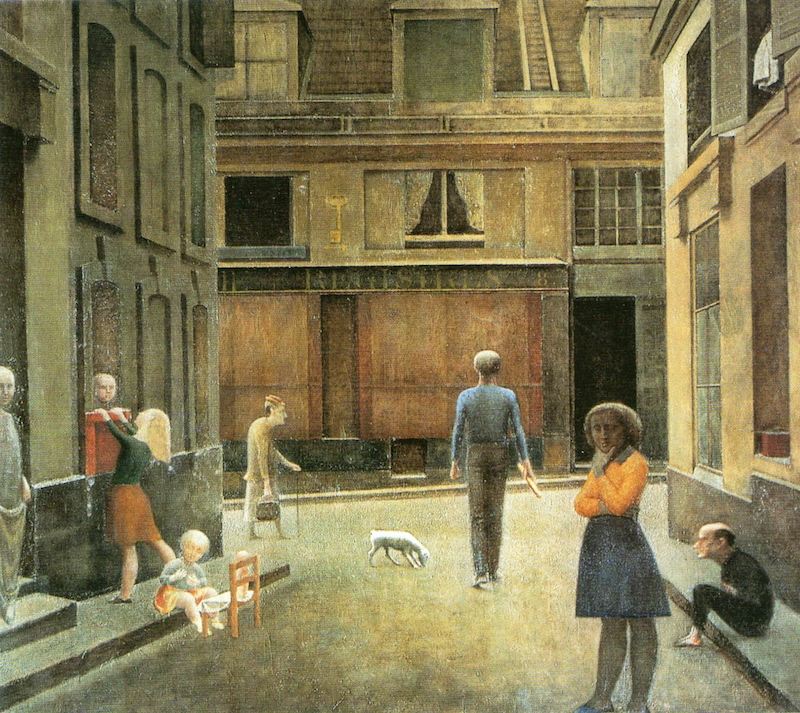
Passage du Commerce-Saint-André, 1952–1954, by Balthus, Fondation Beyeler
Some viewers laugh when they see Balthus’ distorted figures, his little scurrying dolls. We recognise them as types while acknowledging their disturbance. In the later Passage du Commerce St. André, 1952-53, the figures seem to be telling us something about life’s passage, its ironies and despairs. It’s another large, theatrical canvas, like walking into a play rehearsal and standing at the footlights when the director shouts freeze. The resulting tableau vivant has a man carrying a baguette with his back to us, an old woman walking off-scene into the wings, a dumpy girl musing straight at us, holding her chin. On the grimy, grey Parisian wall behind there’s an advertisement for a locksmith’s with an arrow beneath it pointing the way out of the frame. It teases, one of a number of question marks this masterpiece sets up.
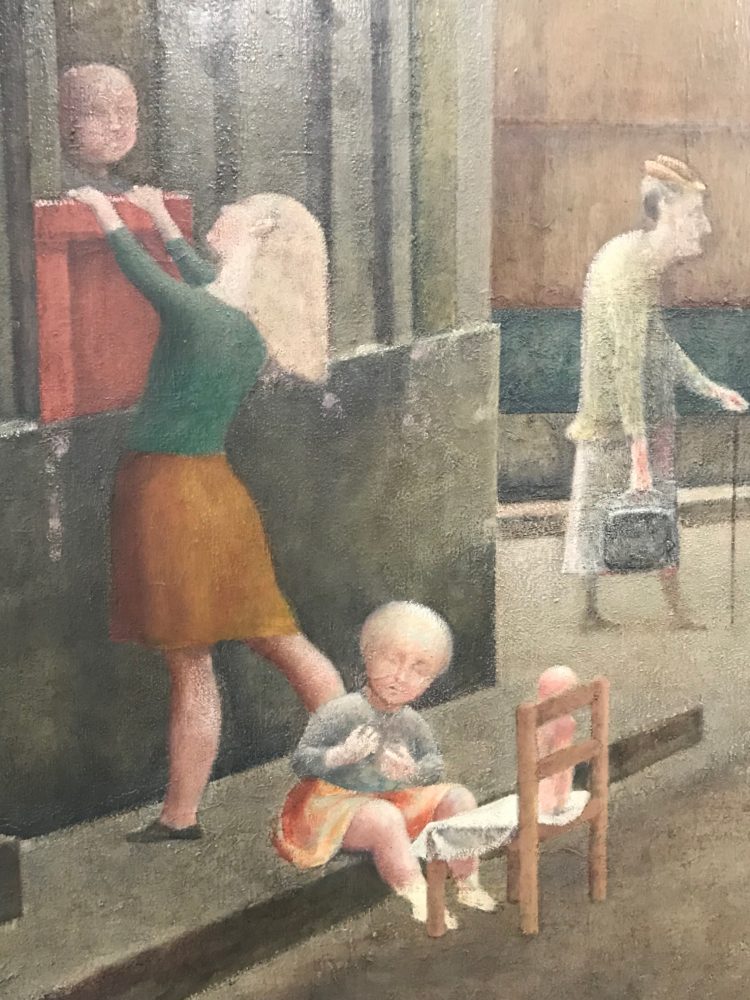
Detail from Passage du Commerce-Saint-André, 1952-1954, Fondation Beyeler
But the real development in these later paintings from the 1950s is in technique, in brushwork. Like Beckett and Giacometti, Balthus takes his obsessions and refines them, honing them to essentials. His brushwork is a stippling impasto, applied, scraped and over-painted until it has the luminosity of Chardin. He prepared his own colours from powder and liked to turn the fluidity of oil into a kind of mortar, working its thickness. Terre de Cassel was a favourite, giving a rich gold hue, the “gold of Velasquez”. He used casein tempera to get a chalky quick-drying effect and a resin called Caparol, mixing colour into a “wax milk” or a treatment he called “la sauce François”. The resulting roughness of paint gives the impression of fresco-work, moving Balthus’ effect closer to that of his long-held ideal artists: Masaccio, Piero della Francesca and Fra Angelico. The matt greys, browns, muted greens and reds of Passage du Commerce St. André play on a chromatic scale.

Detail from Passage du Commerce-Saint-André, 1952-1954, Fondation Beyeler
As the brushwork becomes broader, more textured, the subject matter becomes a matter of light falling on planes of colour, geometrically arranged. The subjects had been developed early. Like the angels, virgins, saints and drapery of devotional art, his figures are givens. The canvases make gestures towards a story about life, desire, voyeurism, perversion – girls, dolls, old age – but the viewer may as well ask why angels have wings.
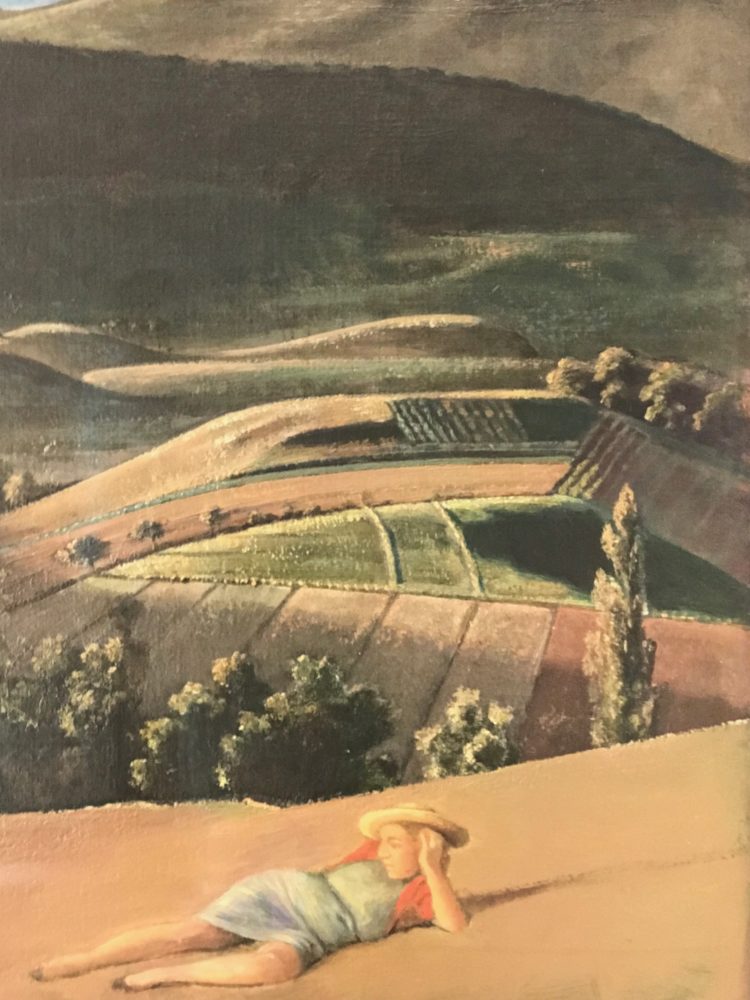
Paysage de Champrovent, 1941 – 1943/45, by Balthus
Balthus is an underestimated landscape painter: the girls steal the show. He captures the mountainous landscape of the Jura and the Savoy, in all its agricultural golds and greens, often in Autumn when the trees are skeletal and the fields gleaned, marked by sharp blue shadow. Like his interiors, the landscape is manicured, in the manner of Poussin’s Classical scenes. In the Paysage de Champrovent above, the dumpy reclining figure seems an afterthought, uncomfortable despite the sun hat, not quite anatomically correct.
In his eighties and nineties, with sight failing, Balthus relied on his wife Setsuko (“the Countess”) to prepare the colours from powder. He took Polaroid snaps of sitters because he couldn’t quite see them well enough in the flesh. A selection from nearly 2,000 snaps of a girl model called Anna Wahli has seen the light of day and they were exhibited at the Gagosian Gallery in New York and Geneva. The youngest daughter of Balthus’ doctor, Anna is interviewed here as an adult about her experience of posing for the master between the ages of eight and sixteen. “Old age had stiffened his hands and he found it difficult to do preparatory sketches.” She posed on Wednesday afternoons when she had a half day off school. In taking the road to photography Balthus joins Lewis Carroll as a photographer of young girls.
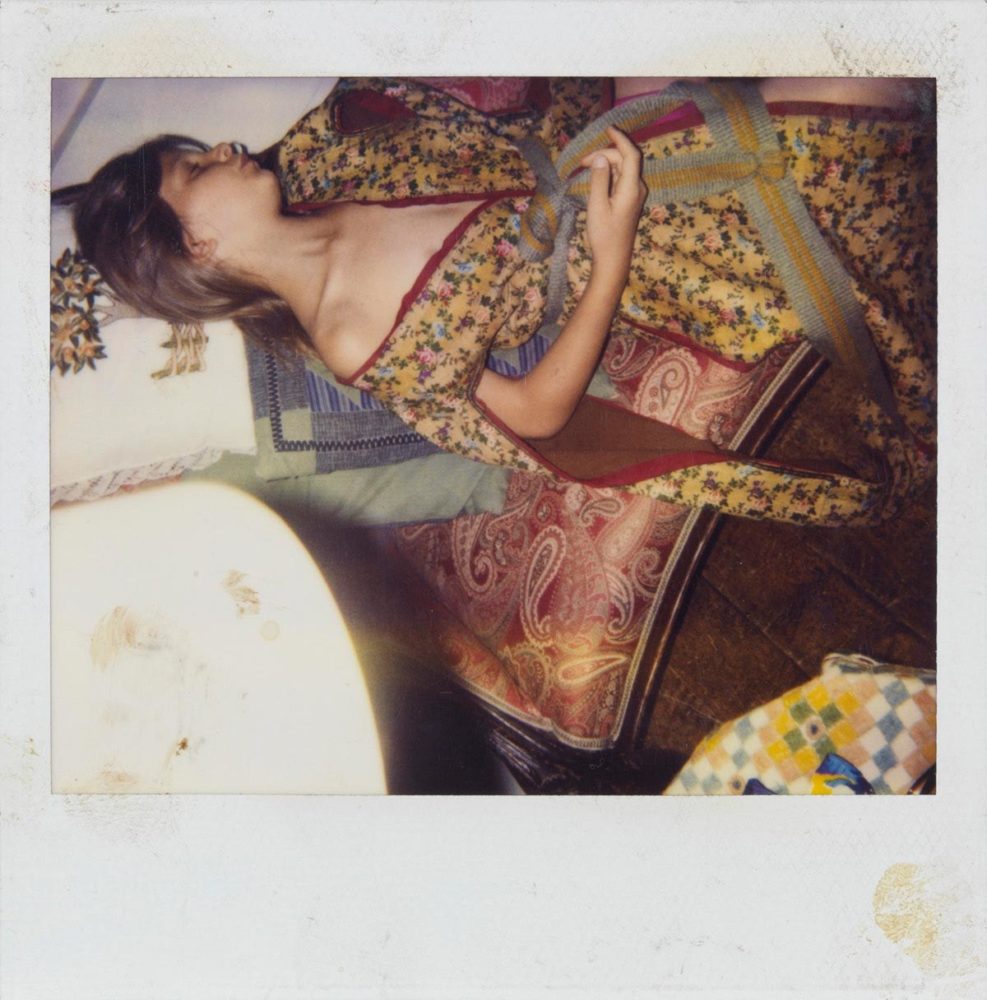
Balthus untitled, c. 1990-2000. ©Harumi Klossowska de Rola. Courtesy Gagosian Gallery
His final residence was Le Grand Chalet at Rossinière, built in 1754, the largest chalet in Switzerland, nestled in the Pays d’Enhaut. For many years it had been a grand hotel whose guests included Victor Hugo and Alfred Dreyfuss. In Balthus’ day there were two Filipino manservants, Leonardo and Virgilio. He liked theatricality and the provocative streak was there to the end. In later photographs he often poses in full dress Japanese regalia – kimono and walking stick. The Rola arms of his putative Polish ancestry were embroidered onto many of his kimono, in the style of Japanese kamon.
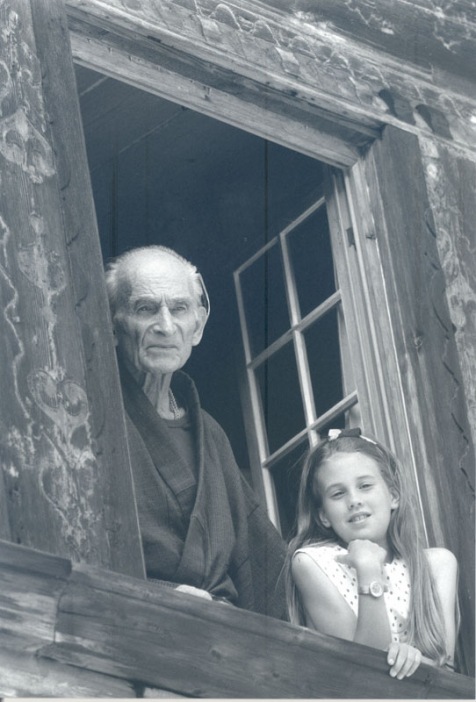
Balthus with model Cybele, 1993, at Le Grand Chalet.
At the Beyeler there’s a little side altar of the exhibition – interactive – where you can respond to statements tacked up on postcards, quotations from Balthus himself. Some of the elderly matrons were cackling at the comments. There was a quote from the artist’s recent critic, Mia Merrill, the instigator of the Met. petition: “The artist of this painting, Balthus, had a noted infatuation with pubescent girls, and it can be strongly argued that this painting romanticises the sexualization of a child.” Merrill is no ignoramus but a former art history student at New York University and an advocate of feminist causes. From the perspective of this wonderful show at the Beyler, the accusation of “romanticising the sexualization of a child” might gain some traction but nonetheless stems from a Puritan legacy, the need to have morally improving art.
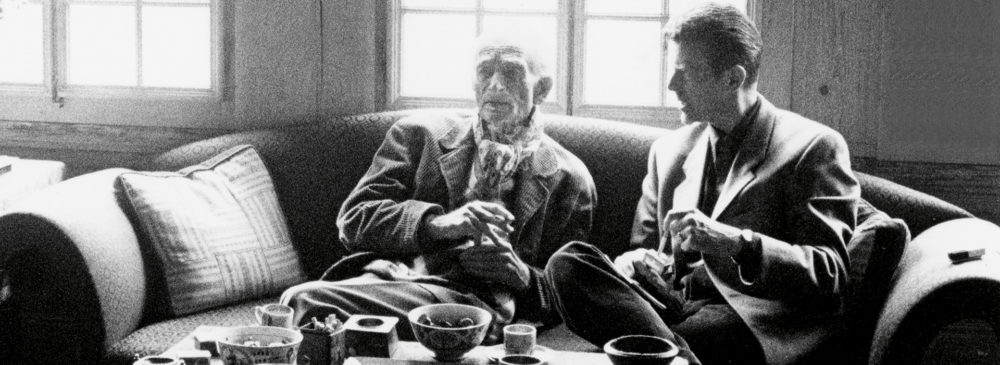
Balthus and David Bowie, interviewing the artist for Modern Painters magazine, 1994.
David Bowie was one of many celebrities and fellow artists who visited Balthus as an old man. They were near neighbours in Switzerland and Bowie was on the editorial board of Modern Painters magazine.
Balthus puts down his knife and fork and, staring at some far off point, says quietly: ‘I awoke very early this morning. I went to my studio and started work. It would not come…. and I gazed at my painting then the small things around me and I felt such a tremendous…sense of awe.’” His voice dies away, leaving “a misty trail of remembrances, glories and maybe disappointments… Locked in silence, we three sit, Balthus, Setsuko and I. The tragedy and chaos of the twentieth century rushes through the memory of its last Legendary Painter.
The Dalai Lama and Tony Curtis visited too. Bono sang for some 350 mourners, including French photographer Henri Cartier-Bresson and the Aga Khan, at Balthus’ funeral in 2001. The artist is buried beside a little chapel not far from Le Grand Chalet, and beside his son Fumio.
Meanwhile, the Klossowski family continues its climb up the aristocratic ladder. Prince Stanislas Klossowski De Rola, Baron de Watteville, commonly known to his friends as Stash, is Balthus’ son by his first marriage to Antoinette de Watteville. He was infamously busted for drugs possession (the Courtfield Road bust) with the Rolling Stones’ Brian Jones in 1967. At one time he was considered for the tv band The Monkees but bowed out of the auditions as being beneath his dignity.

Prince Stanislas Klossowski De Rola, Baron De Watteville, otherwise known as Stash, photographed in 1965.




